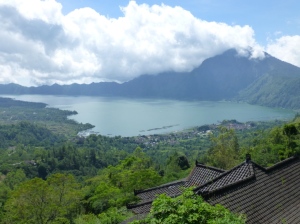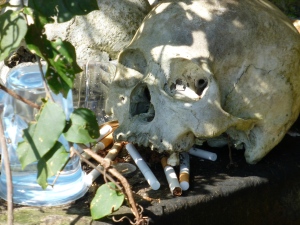In Trunyan there is neither burial nor cremation. The dead are taken from the village by boat to a small clearing around the cove. Bodies are partially covered with a thin white cloth, placed under a fragile bamboo cage and simply left. The cadaver is at the mercy of nature and the elements. It is ravaged, rots and decomposes until just the skeleton remains.
Only 11 bodies can lay there. When the space is needed skulls are removed and placed trophy - like on stone shelves. The rest of the bones are discarded, often just casually tossed on the fringes of the clearing. To the Bali Aga, or Original Balinese, all that matters is the souls and that has long since departed.
The people are the aborigines of Bali. Now they account for only two percent of the population. They were usurped by the Hindu - Javanese who came to the island in the 13th century and flourished. The Bali Aga retreated phisically and mentally into isolated communities and remain a breed apart.

Trunyan itself sits on the eastern side of the mighty crater lake across from Batur Mount, an active volcano. A rock wall rises sheer behind the village. Beyond that is Agung Mount, Bali's highest mountain and a home to the Gods. The Batur caldera is undestandably popular with tourist but only a sparse few venture around the lake to Trunyan. The village's contradiction is to have an ugly reputation while all around is great natural beauty.
Until compartively recently the only way in was to hire oarsmen to row you across the lake. There are legendary tales of the boatmen stopping half way and threatening startled tourist if they didn't pay a hugely inflated price. For those that made it to Trunyan they were often confronted by aggressive begging, exorbitant prices and an intimidating atmosphere.
A couple of years ago a narrow, potholed and twisting road was opened around the lake. The Bali Aga asked the Indonesian tourism authoritiesfor helpin promoting the village to tourist. Strict promises to change their ways were demanded in return. Prices were to be fixed and transparent and visitors were not to be harmed. Trunyan actually has three cemeteries.
The First, Sema Bantas, is for people who died unnatural deaths. Here, bodies are buried in unmarked shallow graves but without ceremony. The Second was the "baby cemetery", Sema Nguda. A place for the young and the unmarried of any age. Finally, Sema Wayah, the cemetery for which Trunyan is known.
The cemetery is in small clearing, quitnesses is all pervasive. For all the expectation of what cemetery experience would be like the anticipation was more disturbing than the reality. The absence of a new corpse with flesh also helped. As did the remarkable fact that the cemetery never has the smell of death. A giant 'Taru Menyan' tree, from which the villages takes it's name, stands in the corner, it's sweet fragrance and its thick, spreading roots are believed to counter the odours. Around the cove the 'Baby Cemetery' in not blessed with a similar tree.
Trunyan is a fascinating place and the Bali Aga are truly different. The villagers of Trunyan have realised that their traditional play directly to our Western fears of death and the macabre. Their naivety there is a danger that they will turn Trunyan into a kind of 'Disney of Death'.

Source:
https://thenony.wordpress.com/
Tidak ada komentar:
Posting Komentar